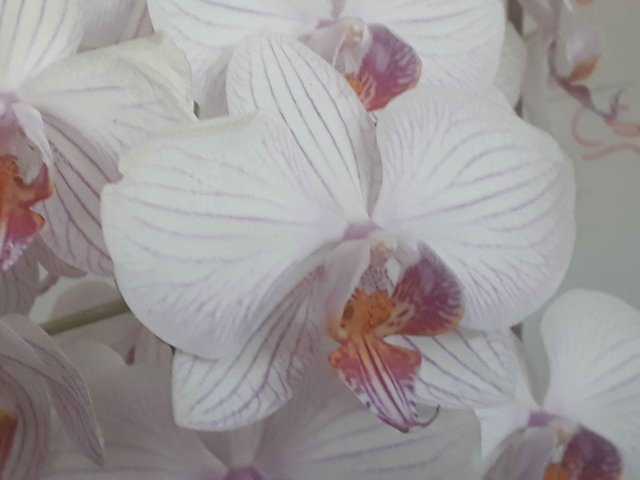
For the last week on my Instagram, I have been sharing images of my beautiful orchid that I've had for a few years now. I used to have this orchid at my work office, but it wasn't happy there. About three years ago was the last time I saw blooms on it. Then last year, both the orchid and I left my place of employment when I decided to work from home, and it has been thriving ever since.
My latest images have been exciting a few of my IG followers, as I mentioned that I would be pollinating them myself, as I tried four years ago. The pollination is an easy process compared to the actual propagation of the seeds, but we will get to that later. The excitement came in when I said I would share images of how I am pollinating them, which I will still do.
However, I wanted to do a small guide on how you can do it yourself too. Usually we rely on flying insects and bugs to do the pollinating for us. Many of us keep our orchids indoor though, which means that pollination of household orchids are rare. This is where human interaction comes in and we form part of the circle of life, aiding our small buddies along.
Please note that these images were taken by myself when I pollinated my orchids this morning. Feel free to use them should you wish to. This article is mostly relevant to the Moth Orchid, and other Orchids may differ in terms of pollination and appearance.
1. PARTS OF THE ORCHID
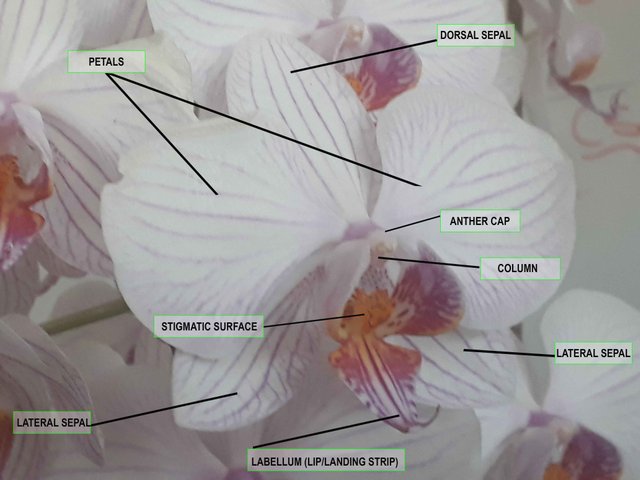
So in this article I will be using various names to discuss the pollination of the orchid flower. So that I don't confuse those who did not study biology like me, let's start off with the parts of an orchid flower:
- Sepals: These are the outermost parts of the bloom, or you could say the parts at the rear of the flower. You have the upper or dorsal sepal, and the two lower or lateral sepals. With the petals, they serve to attract insects to them for pollination.
- Petals: These are the innermost parts of the bloom, or the front parts of the flower. There are three of them, and you can see two of them on either side of the reproductive system.
- Labellum: This is the third petal, which consist of two parts fused together with the lip, or landing strip, in the center. This is where insects will land when coming to visit the flower.
- Stigmatic surface: The stigma forms part of the pistil (female part) of the flower, and in the case of the orchid this consists of three lobes fused together. The lower end is called the stigmatic surface which lures the insect in with a promise of nectar.
- Column: In most other plants, the sexual parts of the flower have a few number of parts, namely the filaments, anthers, style, and stigma. Here, the number of parts are reduced to the Column and the Anther at the end. The ovary consists of three carpels fused together.
- Anther Cap: This is where the male part of the plant is situated, with the Pollinia, or pollen, within it.
2. How Orchid Pollination Happens Naturally
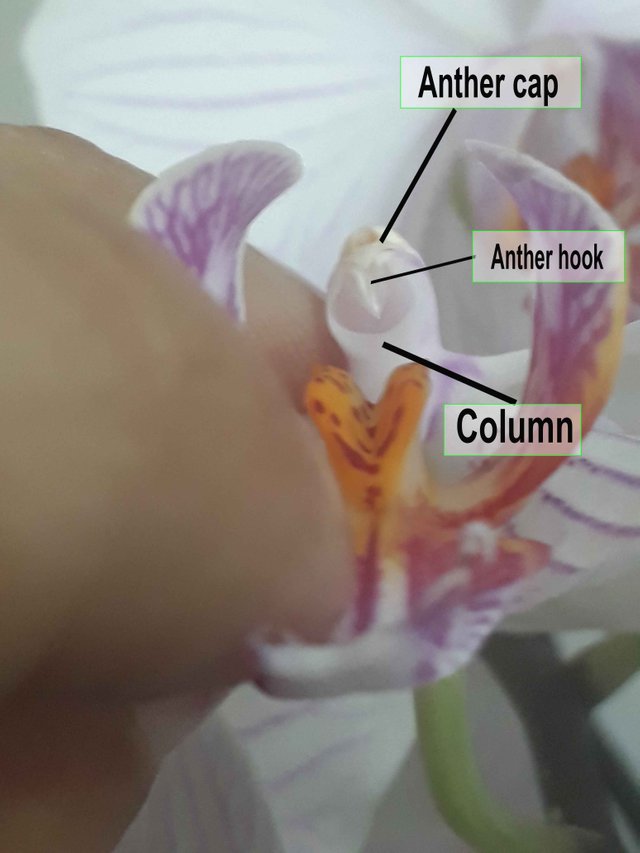
Orchids are monoecious, or bisexual, which means that it has both male and female reproductive organs on them. This consists mainly of the column with the female parts, and the anther with the male parts. At the end of the column is the Anther Cap, which contains the anther and two pollinia / pollen sacs. You cannot see the pollen at first, as it is well hidden under the cap.
So with orchids, you get two types of ways that they attract insects to them. The one type of orchid actually has sweet nectar within them, which the insects then come to feed on. The other type attracts them with the promise of nectar (either through smell or appearance), but actually has none.
Either way, the insect lands on the landing strip and searches for the nectar. While it does this, a small hook on the anther scrubs on the surface of the insect. This action yanks the cap off, and the anther is attached to the insects body. When the insect goes to the next orchid flower to investigate, the pollen rubs against the column. There is a sticky surface inside the column which the pollen attaches to. The column then "rolls" the pollen down towards the ovaries, where it is fertilised.
3. How to Pollinate the Orchid Yourself
In this guide, I will show you how you can egg this on (pun intended). As you can see in the previous section, it is very rare that your house orchid will be pollinated naturally. So if you would like to see your own orchid bare seeds, you can make this happen!
1 - The first thing that you need to do, is create a clean area to work on. The pollen are very small, and will be easily lost in a messy environment. Even though the anther has two pollen sacs per flower, the last thing you want is for this to go missing.
2 - The next step is selecting your instrument in working with the pollen. I used a toothpick, as the sharp point works easily and the pollen attaches to it quite quickly.
3 - Now you need to carefully hold your flower in your hand, and slowly hook the anther with the instrument. The cap should fly off when you do this, or remain attached to the anther itself. What you want, is the anther to attach to the instrument and place it carefully on a clean surface.
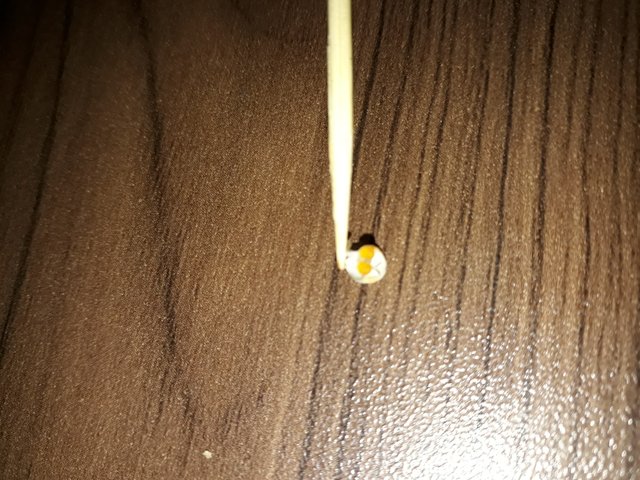
4 - Carefully remove one of the pollen sacs from the anther. You will see there is a sticky substance holding it in place, so the pollen might snap back to the anther. In the end, the pollen should stick to your instrument. If not, just wet the tip of instrument a bit and the pollen should stick right to it.
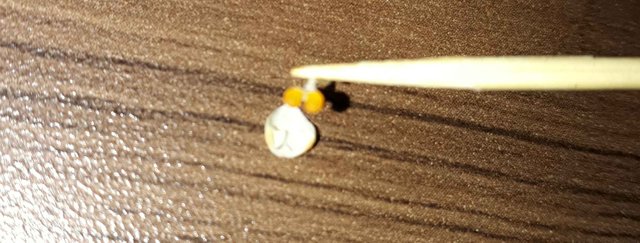
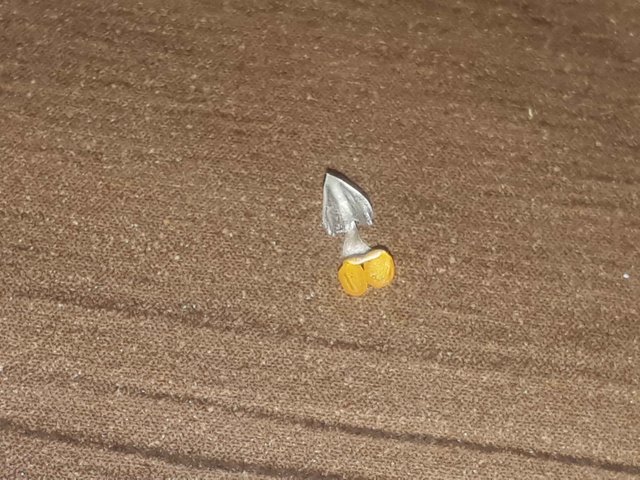
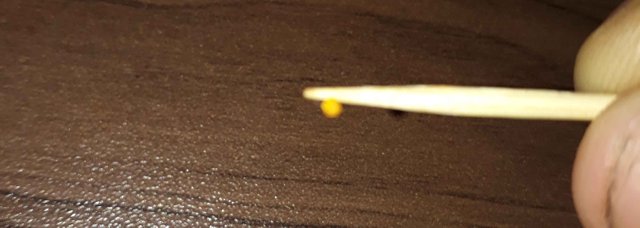
5 - If you've ever had wild dreams of having sex with a flower, here's your chance. It is time to have intercourse with it. In other words, time to place the pollen inside the column. You need to place it in a different flower to the one you took the pollen from. It can be on the same plant, just use a different flower. Then you can use pollen from the second flower and fertilise the first.
Move the pollen on the tip of your instrument to the opening of the Column. The opening is just underneath where the Anther Cap was. You will see small fang-like structures over the opening, which is usually what helps the flower rake the pollen off the insect.
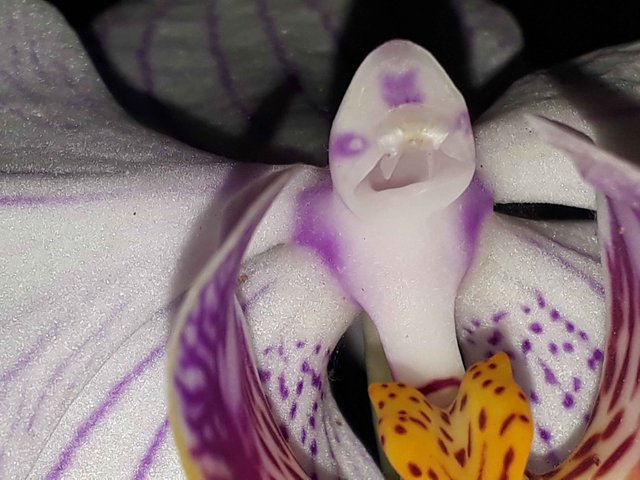
The pollen should move from your instrument to the inside of the Column easily, as there is a sticky substance inside the Column too just for this purpose. Try and push the pollen in as far as possible without hurting the Column. The Column will push it down further, but I try and get it in as much as I can.
And that's it. You have successfully pollinated the orchid flower. Now you just need to wait to see if it has successfully fertilised.
What to Expect Next
As I only pollinated mine this morning, I don't have images yet to show you what mine look like once the fertilisation is successful. Basically, the flower will start to collapse upon itself and close up. Then, a long seed pod will form, which will hold hundreds of tiny cotton type seeds. Once mine have started doing this, I will share some images of the process.
To Pollinate, or not to Pollinate? That is the question.
The essential question is, as fun as this process is to perform and witness, should you be pollinating? You see, pollination is the easy part. Propagation is the tricky bit. You need to be very clinical and scientific when trying to grow the seeds. I will be sharing the process with you in a different post, but basically you need to sanitise everything you use and create an almost laboratory-like experience. And even by doing the process right, you have a slim chance of getting any seeds to grow.
Then again, you could make some profit out of selling the seeds to people who are very successful in this arena. Of course, if you get hundreds of orchids to grow from one pollination, that in itself could be quite a healthy profit. Or you could just grow your own orchid for the love of orchids.
For me, it started as a curiosity as to how orchids are pollinated. Once I saw that I could do it myself, it became like a science experiment to me. I tried to grow the seeds myself at home, but sadly I think I waited to long and the seeds were no longer viable. But I would like to try again and hopefully be more successful this time.
Please feel free to follow me on Instagram where I will be sharing more pics in time to come of the Orchids once they start growing the seed pods.
Please support my work by subscribing for FREE to one of the following:
@shadowolfdg is a  SteemPunk and Steemit article Mentor for @schoolofminnows
SteemPunk and Steemit article Mentor for @schoolofminnows
Member of @teamsouthafrica
Post of the Day Award - @adsactly
Official Promoter for @tpot -- join our discord channel
Kind regards
Shaun M Jooste
Joint-Owner: AIR Entertainment (https://airentertainment.biz)
Director: Celenic Earth Publications (https://celenicearthpublications.wordpress.com)
Author, Screenwriter, Gamewriter, Journalist (https://celenicearth.wordpress.com)




This is really an interesting post. I have one orchid at home, which is flowering every year, but I see some flowers has started to fall off already, thus I think it might be to late to try and pollinate them??
How does the seeds grow in nature, as it definitely will not be sanitized in nature, I would also like to give this a go!!
Thanks for sharing.
Downvoting a post can decrease pending rewards and make it less visible. Common reasons:
Submit
I'll be doing a follow up posts on how the seeds grow in nature compared to how we grow them. I've had to research it myself and also wondered the same question about the sanitary value of nature
Downvoting a post can decrease pending rewards and make it less visible. Common reasons:
Submit
Thanks, I am looking forward to it.
Downvoting a post can decrease pending rewards and make it less visible. Common reasons:
Submit
Thank you for sharing this, I would never have thought of cross pollinating myself, most informative! We have some beautiful orchids which thrives in the humidity of Durban, my son who lives in Joburg just shakes his head as they battle to get theirs to grow.
Posted using Partiko Android
Downvoting a post can decrease pending rewards and make it less visible. Common reasons:
Submit
My orchids always suddenly rot before the year ends, and never rebloom. Usually after someone spills water over the crown, or after I change the growing medium (too late).
You have this down to a sciences indeed.
Downvoting a post can decrease pending rewards and make it less visible. Common reasons:
Submit
I cant remember the last time I changed the growing medium or even fed them orchid food. It just seems to like the spot i have it in I suppose. It seems happy there
Downvoting a post can decrease pending rewards and make it less visible. Common reasons:
Submit
I like flowers but I don't really have it around where I leave. Pollination is really important. Nice post.
Downvoting a post can decrease pending rewards and make it less visible. Common reasons:
Submit
Hi, @shadowolfdg!
You just got a 0.01% upvote from SteemPlus!
To get higher upvotes, earn more SteemPlus Points (SPP). On your Steemit wallet, check your SPP balance and click on "How to earn SPP?" to find out all the ways to earn.
If you're not using SteemPlus yet, please check our last posts in here to see the many ways in which SteemPlus can improve your Steem experience on Steemit and Busy.
Downvoting a post can decrease pending rewards and make it less visible. Common reasons:
Submit
This post was curated by @steemsouthafrica
and has received an upvote and a resteem to hopefully generate some ❤ extra love ❤ for your post!
JOIN US ON TWITTER
Proudly associated with The Power House Creatives
and their founder @jaynie
JOIN US HERE
Downvoting a post can decrease pending rewards and make it less visible. Common reasons:
Submit
Interesting to see how you work with orchid pollination, my orchids are all growing in trees in the garden, this is not something I would have looked into at all, thanks for insight @shadowolfdg
Downvoting a post can decrease pending rewards and make it less visible. Common reasons:
Submit
A great and descriptive post here my friend.
I bet many orchid lovers can benefit from reading this.
Blessings!
Downvoting a post can decrease pending rewards and make it less visible. Common reasons:
Submit
This post was shared in the Curation Collective Discord community for curators, and upvoted and resteemed by the @c-squared community account after manual review.
@c-squared runs a community witness. Please consider using one of your witness votes on us here
Downvoting a post can decrease pending rewards and make it less visible. Common reasons:
Submit
Very beautiful
Posted using Partiko Android
Downvoting a post can decrease pending rewards and make it less visible. Common reasons:
Submit
Congratulations @shadowolfdg! You have completed the following achievement on the Steem blockchain and have been rewarded with new badge(s) :
You can view your badges on your Steem Board and compare to others on the Steem Ranking
If you no longer want to receive notifications, reply to this comment with the word
STOPVote for @Steemitboard as a witness to get one more award and increased upvotes!
Downvoting a post can decrease pending rewards and make it less visible. Common reasons:
Submit
Congratulations @shadowolfdg! You received a personal award!
You can view your badges on your Steem Board and compare to others on the Steem Ranking
Vote for @Steemitboard as a witness to get one more award and increased upvotes!
Downvoting a post can decrease pending rewards and make it less visible. Common reasons:
Submit